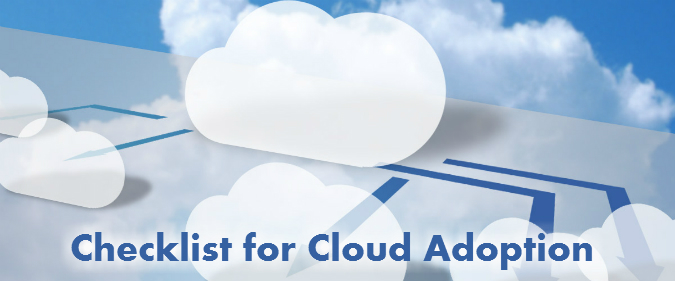Checklist for Cloud Adoption

If your company does not use cloud computing as part of daily operations, there is a good chance to break into the model in the coming time.
One of the main benefits of the cloud is its ability to outsource the infrastructure and management of complex applications and data services, allowing data center manager to purchase computing cycles and storage capacity in a more granular fashion, on demand. Instead of spending capital in bulk for large servers and storage solutions, you can buy time based computer on actual usage of CPU cycles and the amount of gigabytes or terabytes in storage used.
Migrating critical data and applications to the cloud can be significantly more cost effective than maintaining the hardware at the company. As your data is stored on the service provider’s infrastructure, there is no need to invest in the purchase of equipment, maintenance or upgrade the web hosting server.
In addition, as data and software are under the responsibility of a provider, the contracting company can reduce the number of IT employees or contractors needed to keep the hardware running on premise, directing them to more strategic activities that add value to the business.
When migrating data from the company to a company that specializes in providing cloud computing solutions, the organization is not only investing in a solution of off-site storage, but also buying a little tranquility. This is because providers of cloud solutions as Amazon, IBM, Cisco, Microsoft and ESDS have trained staff which is ready to respond to emergencies, frustrations and failures 24 hours a day, 365 days a year, ensuring that the company and employees have access to files and business applications. Furthermore, they give the necessary assistance when requested. By default, cloud computing offers a backup solution instant off site that is running. In cases of disasters in the office, for example, business continuity is assured, thanks to the fact that information is replicated to another location.
Having a solution of cloud computing means to grow rapidly and meet the demands of employees and customers. As businesses grow, the cloud-based solution can quickly be scaled to meet the growing needs. Such movement may be especially important for businesses that rely on web sales as a significant representation of the recipe. The lack of server capacity can quickly result in lost sales.
In essence, the cloud changes its cost structure and managing IT from the purchase of equipment, hiring professionals and operation of internal data centers to service-oriented paradigm on which you buy just what you need when you need. Becomes someone else’s problem to make sure everything is secure, available and reliable.
However, there are always advantages and disadvantages to surrender control of IT to another person. You need to make sure it is worth it, and it works.
Here are ten points to consider before adopting the cloud:
- Is the contract good enough to protect you, no matter what happens with the cloud provider?
- What happens if or when the provider fails?
- How can you change providers and move the data if you want to leave the service?
- Do you know your current internal costs, and will migrate to the cloud to reduce them?
- Is there some flexibility in the ability to choose products from specific vendors, or you’re stuck to what is offered?
- If your desire to outsource storage, are there performance concerns?
- If there are concerns, are there any guarantees?
- What about data security and encryption?
- If you are in a multi-tenant environment, will there be some logical or physical isolation?
- Which aspects of reliability are implemented and available? Is there a scale-based cost for reliability, availability, scalability, and everyone has the same solution?
All these factors are important and must be considered when you evaluate whether cloud computing makes sense for your organization or not!!
Resources:
- https://www.esds.co.in/dc-infrastructure.php
- https://www.esds.co.in/enlight-cloud-hosting.php
- https://www.esds.co.in/private-cloud-hosting.php
- How Cloud Computing Is Changing The Labor Market - March 25, 2015
- Adopting Infrastructure as a Service Can be a Good Deal - March 17, 2015
- Will Virtualize? Take These Six Points Into Consideration - March 12, 2015